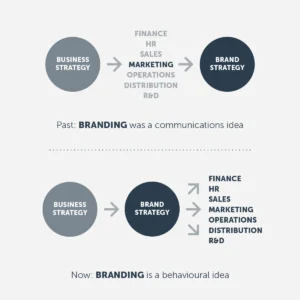General Business Strategy
Why you should focus internally before marketing to potential customers.
You’ve taken the leap and you’ve been working hard.
You’ve developed a new marketing strategy that’s perfectly constructed to target your ideal prospects; part of this is a total refresh of what the business and the brand are all about, and you’re sitting on the very brink of pushing the button to unleash a new website along with campaigns and new messaging that will supercharge your business and successfully launch the next stage of growth…
The excitement is palpable, the rocket is on the launchpad. And here’s what you should do next:
You should hit pause.
Because if you haven’t yet got your team well and truly on board with the coming changes, you could be about to launch a mission impossible!
Yes, before you step up your external marketing, it’s time to do some internal marketing.
What exactly is internal marketing?
It’s when you persuasively communicate your brand and marketing strategy to your team, getting them on board with all of the new messaging, positioning and selling points that you’ve developed to sell your products or services to potential (and current) customers.
It should also cover off the company’s goals, along with any vision, mission or purpose statements you happen to have, as well as making it clear what the external marketing expects to achieve.
Some of this might be done when an employee starts working for you, but any time there’s a significant change in the business, whether it’s a marketing strategy or a new service or product to be launched, then you need to communicate all of that internally too, before telling anyone else. And why is that, you might ask..?
Well try this test to see how you’re going without it. Simply ask employees this question: “What does our brand stand for and why should customers care?”
Did the answers shock you? Harvard Business Review found that 72% of employees couldn’t recall any company goals!
So, we’re going to give you some ideas on the best way to approach your internal marketing, but first of all allows us to outline the benefits of getting it right.

What exactly is internal marketing?
It’s when you persuasively communicate your brand and marketing strategy to your team, getting them on board with all of the new messaging, positioning and selling points that you’ve developed to sell your products or services to potential (and current) customers.
It should also cover off the company’s goals, along with any vision, mission or purpose statements you happen to have, as well as making it clear what the external marketing expects to achieve.
Some of this might be done when an employee starts working for you, but any time there’s a significant change in the business, whether it’s a marketing strategy or a new service or product to be launched, then you need to communicate all of that internally too, before telling anyone else. And why is that, you might ask..?
Well try this test to see how you’re going without it. Simply ask employees this question: “What does our brand stand for and why should customers care?”
Did the answers shock you? Harvard Business Review found that 72% of employees couldn’t recall any company goals!
So, we’re going to give you some ideas on the best way to approach your internal marketing, but first of all allows us to outline the benefits of getting it right.
Get everyone talking the same language, land more work from your current customers and new customers
If you’ve spent considerable time talking to customers, prospects and researching the market, then developed the sharpest, most powerful messaging you can possibly imagine to persuade your customers to pick you! Phew… You’d be mad not to communicate all of that to your employees too.
If your website says one thing, and the person at the end of the phone says another, then you’re not going to come across as a very professional outfit, to say the least. The reverse, of course, is when everyone knows exactly what to say, to present your business in exactly the same way, making you more persuasive.
At some point a prospect is going to communicate directly with an employee, whether sales or customer service or the receptionist. Internal marketing influences how that interaction is going to play out, and that’s going to affect the sale.
Real human connection still has a massive influence on our purchasing decisions. Especially in the B2B world, where often it’s a service-oriented business.
As well, it’s critical that the promises your marketing makes to clients and prospects is echoed and expanded upon by your team, get that wrong and you simply look disorganised at best and untrustworthy at worst.
If the prospect’s personal experience is out of line with the expectations you set through your brand and marketing, the dissonance can result in dissatisfaction. Anybody remember Telstra’s slogan “It’s how we connect” while at the same time cutting back on customer services so you simply couldn’t reach anybody without waiting for hours? The backlash was savage.
Research also shows that companies with formal employee advocacy/internal marketing programs have shorter sales cycles and find it easier to attract (and keep) new business.
Involve your employees, increase their engagement
If people are actually involved in what’s going on, rather than ignored or simply emailed as an afterthought, then they’ll become more enthusiastic about the change. This can lead to increased levels of motivation, productivity and all that good stuff.
Taking the time to properly explain, and even involve them (perhaps) in the process makes people feel truly valued in the organisation, helps build a positive, collaborative culture, and helps them become better brand ambassadors too. Brand messages reached 561% further when shared by employees vs the same messages shared via official brand social channels!
Engage your employees, increase retention & ease recruitment
All of the above, if you get it right, helps make your business a great place to work, and when that happens people tend to hang around a lot longer. Carrying all that collected institutional knowledge with them and passing it onto the new recruits, as opposed to disappearing to work for your competitors.
You’ll also find recruitment is easier, because prospective applicants understand clearly what you’re about and in time word gets out, and employees may even reach out to friends about upcoming roles. Greater retention, easier recruitment: happy days.
Of course, internal marketing isn’t entirely responsible for all of that, but it can be a powerful contributor.

So now you get it, some tips about how to do it…
How to approach your internal marketing
- Develop a plan and use your marketing resources to make it look great
Depending on the size of your organisation, you may decide to communicate to everyone at once, perhaps with a presentation or speech followed up with a series of carefully created marketing materials, that reinforce the new position convincingly.
If the business is large enough, it may even be worthwhile adjusting a couple of variant streams of communications, tailored to each specific department – customer-facing and back-office for example. Whatever you decide, make sure it’s well considered and thought-out, not simply an afterthought. People can tell, and they’ll be suitably unimpressed.
And speaking of impressed, make sure it looks great! Marketing designed the brand, get marketing to design your internal comms too, at the same standard. Anything less will show a lack of care on your part and will undermine support.
- Pick your moment
Whether it’s a brand strategy, mission, major new partnership, product change etc, use internal marketing whenever there’s a notable change.
If you can try to gauge the mood, and adjust accordingly this will go a long way to helping employees not only accept, but actually get excited about the change in direction.
- Ensure it comes from the top
Seems kind of obvious, but any significant change needs to be launched, supported and championed from the top. You should also engage your executive team, and senior managers accordingly to ensure the messaging is reinforced over time. This builds commitment, trust and conviction – unless it’s the third time in six months you’ve changed direction, in which case refer back to point 2!
- Encourage feedback
Once again, how you do this depends on the size of your business, but at the very least
you should encourage employees to ask questions, provide feedback, and then, most importantly, actually listen and adjust accordingly if the points are valid.
- Repeat, repeat, repeat
Cultures can be hard to change, it takes time but if can be done. Like all marketing efforts, repeat, repeat, repeat across all touchpoints to embed and reinforce the new strategy. Whether it’s meetings, newsletters, company policies, even the décor of the office itself, find way to bring it to life. All of that builds the culture around the brand and the values, while layering and reinforcing the messaging at the same time.
- Measure and monitor
Your approach here, once again, will depend on the size of your business. You can simply ask around, or use a survey to determine the level of understanding around the new brand or marketing strategy. Other metrics to watch will be employee satisfaction, and if you’ve engaged the workforce properly retention levels should rise. And finally, whatever the business goals are, the very reason behind the change in direction, over time you should see a change in the metrics that indicate success in that regard. In fact, we’ve written another blog about that right here.
Your people are your greatest asset – prioritise them as such!
Your own team are probably the most powerful factor in your success or otherwise. For this reason, arguably they are also your most important brand target. If you can’t even get them on board, how effective will you be in the broader market?
This is why you need a healthy brand on the inside and your marketing department is best positioned to help you achieve it.
How you approach all of this, of course, will depend on your business, how many employees you have, and what the new strategy encompasses too. The most important point, however, is to make sure you engage in some kind of internal marketing first, before broadcasting it to the world – and ongoingly to reinforce it and keep it fresh.
The InsideOut Solution
If you’re wondering how you can manage all this within your skillset and resources, you’re not alone, which is why we’ve developed a new way for SMEs to access the senior talent they need to grow their business, without paying for a full time employee.
Because not doing any marketing just isn’t an option, and doing it badly wastes your time, and your money too. So please, contact us instead and we can quickly explain our structural approach to solving marketing resourcing on a tight budget.




